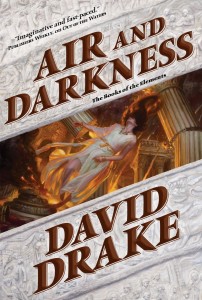Air and Darkness is the fourth and final book in the Books of the Elements Series. It will be available November 2015 from Tor.
The setting of this novel and of the series, The Books of the Elements, is the city of Carce (pronounced KAR-see, as in The Worm Ouroboros) and the empire which Carce rules. These are extremely similar in history and culture to Rome of 30 AD.
Carce is not Rome, however. This was implicit in the earlier Books of the Elements, though the fact seems to have passed over the heads of some commentators. The difference becomes explicit in the conclusion of Air and Darkness, but it’s been there all along.
The society of Carce, like that of Classical Rome, is built on slavery. In the Books of the Elements I generally use the term “servant,” but this almost always means “slave.” The horrors of slavery are not my subject–I tell stories; I don’t send messages–but I’m well aware of those horrors.
War, like slavery, is an awful business. When I began writing Military SF in the early ’70s, I described war as I had experienced it in Vietnam and Cambodia: my viewpoint characters, my heroes, saw and did terrible things; as I had seen and done terrible things. At the time, quite a number of commentators believed that I must be advocating the things which I described.
I was not advocating war then, and I’m not advocating slavery now; but my heroes are slave-owners and not particularly enlightened about it. To describe them otherwise would be to give a false picture of their society and the society of Classical Rome on which theirs is modeled.
I don’t apologize for this, any more than I apologize for giving civilians a glimpse of the reality of war in Hammer’s Slammers. Many pundits of the ’70s and ’80s were horrified by that reality and angry at me for describing it. If what I imply about slavery angers people who romanticize the civilizations of the Classical World or the Antebellum South, so much the better.
As in previous Books of the Elements (and in my fiction generally), I use real places and events whenever possible, and I often work literature and folktales into my fiction. The tags from the Sibylline Books are real, and classicists may recognize (loud) echoes of the Dionysiaca of Nonnos in Air and Darkness.
I suspect even most classicists are unlikely to recall the City of Magicians which Philostratus describes as being located between the Ganges and Indus river basins in Northern India; and I have taken the haunted city buried in the Indian jungle from The Adventures of a Younger Son by Edward John Trelawny. I don’t vouch for the historical accuracy of either Philostratus or Trelawny, but I didn’t invent the stories.
I’ve taken a number of the incidents and themes from Indian folktales. One of them put me in mind of Apollonius, King of Tyre; which made me wonder how many Greek prose romances may have been drawn from Indian originals (or the reverse, of course).
There’s an enormous non-literary influence on Air and Darkness: my trip to Italy while I was planning it. This comes through in matters as minor as the carpet of acanthus beneath the Tarpeian Rock, to my description of Bomarzo: ancient Polymartium.
Bomarzo, carved into the Park of the Monsters in the 16th century AD, has an amazing spiritual aura which I hope pervades Air and Darkness. I expect the experience to be part of everything I write for the rest of my life.
And that’s not a bad thought with which to end this introduction and the Books of the Elements themselves: there is a truly wonderful world out there. Open yourself to it, become a part of it. There are Bomarzos around the corner for every one of us, if we’re just willing to accept them.
–Dave Drake
